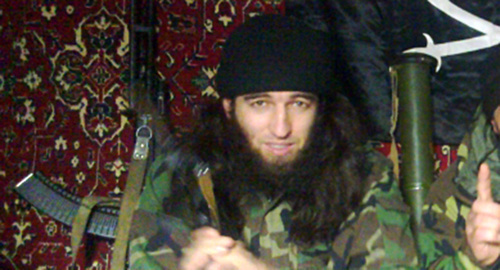
Islamic State Branch in North Caucasus Follows Same Organizational Pattern as Caucasus Emirate
Publication: Eurasia Daily Monitor Volume: 12 Issue: 196
By:

The head of the Russian Investigative Committee’s branch in Dagestan, Eduard Kaburneyev, recently made public that a criminal investigation has been launched into the establishment of the “Velayat Dagestan of the Islamic State” criminal group (Gazeta.ru, October 22). The Investigative Committee has named Rustam Asilderov (Emir Abu Muhammad al-Qadari) and Gasan Abdullaev (Emir Abu Yaser) the organizers of the group, which they accuse of attempting to change the foundations of the constitution of Russia with the goal of violating the territorial integrity of the country. It took the Dagestani investigators a year to realize that a branch of the Islamic State (IS) had been established in the republic, and that its primary objective was “to carry out especially grave crimes, including terrorism” (Kavkazsky Uzel, October 23).
The rebel amir of Dagestan’s Khasavyurt district, Suleiman Zailanabidov, was among the first to pledge allegiance to the Islamic State’s self-proclaimed caliph, Abu Bakr al-Baghdadi. Zailanabidov took the oath of allegiance on November 21, 2014. Later, on December 19, Rustam Asilderov, who was then the amir of Dagestan in the Caucasus Emirate, also pledged allegiance to the new caliph (Kavkazsky Uzel, December 20, 2014). In the summer 2015, Chechen and Ingush militants followed the lead and themselves joined the Islamic State. IS spokesman Abu Muhammad al-Adnani made a special statement confirming the existence of an official IS branch in the North Caucasus (Nation-news.ru, June 24). The IS appointed Asilderov, who comes from Dagestan’s Kadar mountain gorge, leader of its North Caucasus branch (Topnews.ru, June 24).
Amir Abu Yasir, who used to oversee the activities of the Caucasus Emirate in southern Dagestan, is another well-known leader of the Islamic State branch in the North Caucasus. Within the IS, he is still responsible for the Tabasaran, Derbent, Suleiman-Stalsky and Magaramkent districts in southern Dagestan. Abu Yasir is known for his highly secretive practices and creating new cells out of the new recruits. The recruits are normally locals who have a semi-legal status and are responsible for setting up their own groups. According to unconfirmed reports, Abu Yasir’s people were behind previous terrorist attacks in Russia, including the attempt to derail the Moscow–St. Petersburg fast train in the summer of 2011 (Kommersant, October 23). According to Dagestani investigators, insurgents often have no connection to their top leaders, which makes uncovering the militant networks especially difficult for the Russian intelligence services. The IS branch in the North Caucasus seems to have followed the same organizational pattern as the Caucasus Emirate.
The Russian Investigative Committee launched an investigation of 19 individuals, which indicates how many suspected members of the Islamic State network in the North Caucasus are known to the authorities. The figure of 19 is not realistic for Dagestan, where even cells in remote villages often have several members in them. Hundreds of active militants likely exist across the republic. In addition, there are probably thousands of sympathizers encouraging and financing the militants. The group of IS militants in Gimry, a village located in Dagestan’s Untsukul district, alone has 16 members, according to investigators (Operline.ru, October 23). Dozens of militants are found in southern Dagestan—two or three dozen in Khasavyurt and many more in Kizlyar, Makhachkala, Buinaksk and other places.
According to investigators, the Velayat Dagestan finances itself by extorting businesses and officials, as well as through ransom payments (RIA Novosti, October 22). However, this is an oversimplified picture: in reality, Dagestan’s militants also certainly receive at least some funding from sources in the Middle East and Turkey.
Having launched a criminal case, the Investigative Committee in Dagestan separated the Dagestani Velayat from the Chechen, Ingush and Kabardino-Balkarian jamaats. Having accused Abu Muhammad al-Qadari of being the leader of all North Caucasian militants operating under the auspices of the IS, the authorities are prosecuting him only for operating in Dagestan. Thus, Abu Muhammad al-Qadari is apparently considered guilty of establishing an IS branch in Dagestan, but not in the neighboring North Caucasian republics.
Government forces declare any militant they kill in Dagestan to be a member of the Islamic State in the North Caucasus. For example, authorities have pronounced that Abdulla Nustapaev, who was killed in Gimry on October 24, was also an IS member (Vria.ru, October 24). In reality, Nustapaev was a member of a group of militants operating under the command of Magomed Suleimanov (Abu-Usman Gimrinsky). Suleimanov was the last amir of the Caucasus Emirate, and it is unlikely that one of his close associates, Nustapaev, managed to make connections with the IS and switch his allegiances within two months.
President Vladimir Putin also spoke of the threat from the supporters of the Islamic State during his Kremlin meeting with Syrian leader Bashar al-Assad. Putin said the Russian authorities could not afford to let militants who fight al-Assad’s forces in Syria to infiltrate into Russia, given that they had received military experience and ideological indoctrination. During that meeting, Putin pronounced that 4,000 militants from the post-Soviet space were fighting in Syria (Lifenews.ru, October 21). That figure, however, probably includes only Russian citizens fighting in Syria.
By siding with al-Assad’s Alawite regime, Moscow went against Russia’s 20 million Sunni Muslims, who comprise the vast majority of the country’s Islamic community. They are insulted and humiliated by Russian support for the Syrian government, which is backed by Alawites and Shi’ites. The gap between the Russian government and the country’s Muslim population stands to increasingly widen the longer Russia’s intervention continues.




